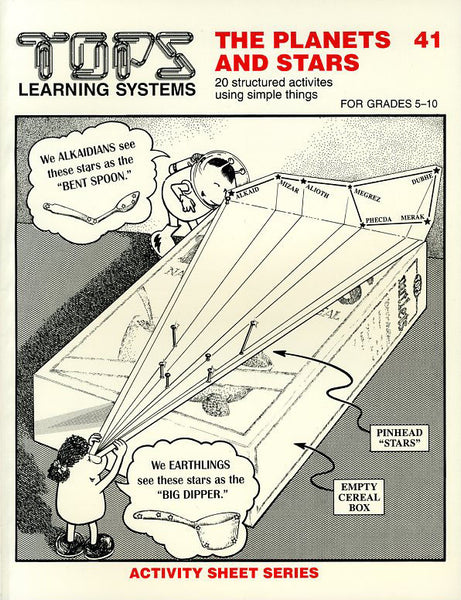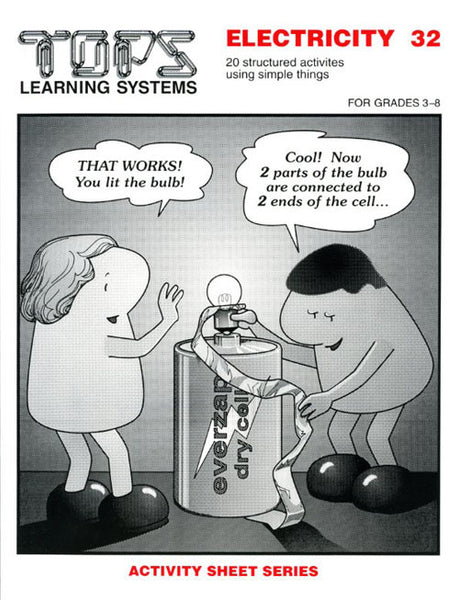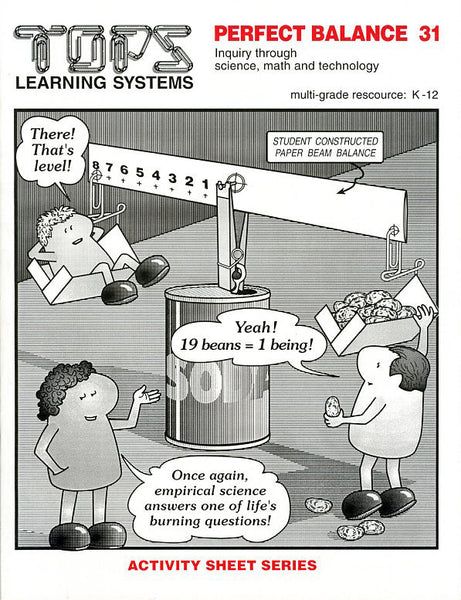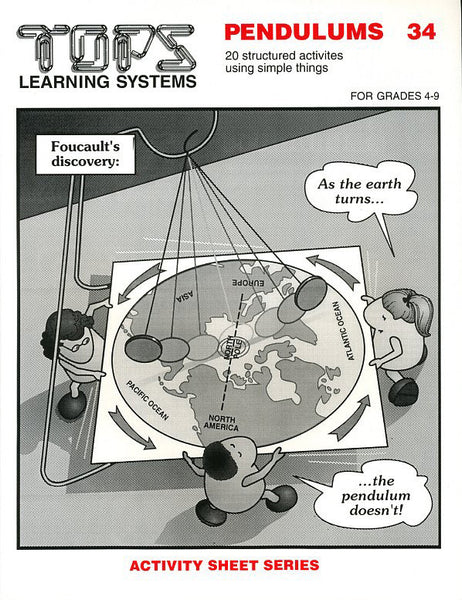#41 The Planets and Stars (grades 7-12)
Regular price $23.95
Soft-bound, 80 page book, 20 reproducible activity sheets, full teaching notes.
Bring the night sky into your daytime classroom or living room. Build clever models to track the sun and stars across your ceiling. Watch constellations rise and set in a baby-food-jar ocean. Pace astonishing distances between a tennis ball sun and tiny planets. See how the Big Dipper looks from other perspectives. Heavenly!
More Information – click any of the tabs below to learn more about this title
Click here for a complete list of materials and convenient shopping.
Key: (1st/2nd/3rd) denote needed quantities: (1st) enough for 1 student doing all activities; (2nd) enough for 30 students working in self-paced pairs; (3rd) enough for 30 students working in pairs on the same lesson. Starred* items may be purchased below.
1/15/15: scissors
* 1/8/8: rolls masking tape
1/2/8: meter sticks
1/1/1: wall clock with second hand (or wristwatches)
* 1/1/1: package standard 1 inch straight pins
1/1/1: package extra long pins, about 1.5 inches (optional)
2/30/30: Post Grape Nuts cereal boxes, 32 ounce size, or equivalent
1/5/15: pennies
* 1/5/5: rolls clear tape
* 2/30/30: straight plastic straws
* 1/1/1: box paper clips
1/3/8: paper punch tools
* 1/1/1: spool of thread
* 1/5/15: metal washers
1/5/15: pounds gravel, large rocks or bricks (optional)
* 1/15/15: medium baby food jars with tight-fitting lids
1/5/15: graduated cylinders, 500 mL (optional)
1/1/1: roll paper towels (optional)
1/3/8: bottles white glue (optional)
* 0.1/1/1: cup oil-based modeling clay
* 1/1/1: bottle food coloring with dropper dispenser, blue is best
1/1/1: roll plastic wrap
1/30/30: flashlights filtered with red cellophane, or red LEDs for night vision
* 1/5/15: hand lenses
1/1/1: stack of standard-sized newspaper, 3 feet high
1/5/15: each, yellow and black crayons or markers
* 3/63/75: generic paper plates, 9-inch diameters with traditional rippled border
1/5/15: drawing compasses
1/1/1: shaker of black pepper
1/1/1: container of coarse sand with pebbles
1/15/15: tennis balls, new or used
1/1/1: roll heavy string
* 1/2/2: package of clothespins (optional)
1/1/1: copy of The World Almanac and Book of Facts, or equivalent on-line reference
1/1/1: a current calendar with moon phases (optional)
1/1/1: ball of cotton
1/15/15: scissors
* 1/8/8: rolls masking tape
1/2/8: meter sticks
1/1/1: wall clock with second hand (or wristwatches)
* 1/1/1: package standard 1 inch straight pins
1/1/1: package extra long pins, about 1.5 inches (optional)
2/30/30: Post Grape Nuts cereal boxes, 32 ounce size, or equivalent
1/5/15: pennies
* 1/5/5: rolls clear tape
* 2/30/30: straight plastic straws
* 1/1/1: box paper clips
1/3/8: paper punch tools
* 1/1/1: spool of thread
* 1/5/15: metal washers
1/5/15: pounds gravel, large rocks or bricks (optional)
* 1/15/15: medium baby food jars with tight-fitting lids
1/5/15: graduated cylinders, 500 mL (optional)
1/1/1: roll paper towels (optional)
1/3/8: bottles white glue (optional)
* 0.1/1/1: cup oil-based modeling clay
* 1/1/1: bottle food coloring with dropper dispenser, blue is best
1/1/1: roll plastic wrap
1/30/30: flashlights filtered with red cellophane, or red LEDs for night vision
* 1/5/15: hand lenses
1/1/1: stack of standard-sized newspaper, 3 feet high
1/5/15: each, yellow and black crayons or markers
* 3/63/75: generic paper plates, 9-inch diameters with traditional rippled border
1/5/15: drawing compasses
1/1/1: shaker of black pepper
1/1/1: container of coarse sand with pebbles
1/15/15: tennis balls, new or used
1/1/1: roll heavy string
* 1/2/2: package of clothespins (optional)
1/1/1: copy of The World Almanac and Book of Facts, or equivalent on-line reference
1/1/1: a current calendar with moon phases (optional)
1/1/1: ball of cotton
- Lesson 1: To fix reference points that line up with true north in your classroom, on the school grounds and at home.
- Lesson 2: To construct a Pointer Box to determine the locations of Polaris and the celestial equator at your latitude.
- Lesson 3: To trace the path of the sun across the sky at its solstice and equinox positions. To observe where the sun rises and sets during different times of the year.
- Lesson 4: To verify that the Sun Straw on the Pointer Box really tracks the apparent path of the sun across the sky.
- Lesson 5: To construct a mini-planetarium in a baby food jar. To model the apparent motion of the sun and stars around our rotating earth.
- Lesson 6: To model how the sun and stars move relative to a flat horizon. To compare this motion at different latitudes.
- Lesson 7: To distinguish between the actual positions of stars in space and their apparent position on the celestial sphere.
- Lesson 8: To plot star position on a polar graph in terms of sidereal time and declination. To use the resulting star map to predict star positions in the daytime sky.
- Lesson 9: To estimate the apparent separation between stars in the Big Dipper. To observe polar constellations in the night sky.
- Lesson 10: To develop a concrete understand of the quantity 'one million.' To appreciate the dramatic increases the result from an exponential expansion.
- Lesson 11: To develop an understanding of astronomical distances within our solar system. To define the speed of light.
- Lesson 12: To distinguish between actual star distances, measured in Light Years, and apparent star separations measured in degrees. To appreciate the vast magnitude of interstellar space.
- Lesson 13: To draw the paths of the orbiting planets in our solar system to scale.
- Lesson 14: To assemble a paper globe that maps the constellations. To compare this model of the celestial sphere of previous models.
- Lesson 15: To cap the Sky Sphere with a Zodiac Ring that fixes the sun's ecliptic position among the constellations in terms of calendar date and sidereal time.
- Lesson 16: To search out constellations in the night sky over the next few weeks and record them on a Sky Wheel.
- Lesson 17: To draw the sizes of the sun and the planets to scale on notebook paper.
- Lesson 18: To model the sizes of the planets and their distances from the sun in the same scale model. To appreciate that our solar system is a very empty place.
- Lesson 19: To track the planets and the moon on the ecliptic circle. To visually identify at least one planet and document its shifting position among the background stars.
- Lesson 20: To model the Milky Way Galaxy and understand its orientation in our night sky. To appreciate the vastness of intergalactic space.
Watch for new developments on the re-, re-, re-classification of Pluto. Formerly a planet, it has been redefined several times in the past few years. Various groups in the the science community have called it a minor planet, a plutoid, and finally (perhaps), a dwarf planet. A large segment of the general public would prefer that it keep its status as a small planet. As of early 2009, the debate may still be in orbit.
Keep a few constructed instruments available in a corner workstation for students who finish tests early, or for constructive activity on rainy days. For example, students might use the mini-planetarium in a jar to predict the rising and setting of constellations that evening, or on a specific date, like a birthday.
We encourage improvisation - it's one of the main goals of our hands-on approach! You and your students might invent a simpler, sturdier or more accurate system; might ask a better question; might design a better extension. Hooray for ingenuity! When this occurs, we'd love to hear about it and share it with other educators.
Keep a few constructed instruments available in a corner workstation for students who finish tests early, or for constructive activity on rainy days. For example, students might use the mini-planetarium in a jar to predict the rising and setting of constellations that evening, or on a specific date, like a birthday.
We encourage improvisation - it's one of the main goals of our hands-on approach! You and your students might invent a simpler, sturdier or more accurate system; might ask a better question; might design a better extension. Hooray for ingenuity! When this occurs, we'd love to hear about it and share it with other educators.
National Science Education Standards (NRC 1996)
Teachers of science...
A: ...plan an inquiry-based science program. (p. 30)
B: ...guide and facilitate learning. (p. 32)
C: ...engage in ongoing assessment of their teaching and of student learning. (p. 37)
D: ...design and manage learning environments that provide students with the time, space, and resources needed for learning science. (p. 43)
• Represent a central event or phenomenon in the natural world.
• Represent a central scientific idea and organizing principle.
• Have rich explanatory power.
• Guide fruitful investigations.
• Apply to situations and contexts common to everyday experiences.
• Can be linked to meaningful learning experiences.
• Are developmentally appropriate for students at the grade level specified.
TEACHING Standards
These 20 activity sheets promote excellence in science teaching by these NSES criteria:Teachers of science...
A: ...plan an inquiry-based science program. (p. 30)
B: ...guide and facilitate learning. (p. 32)
C: ...engage in ongoing assessment of their teaching and of student learning. (p. 37)
D: ...design and manage learning environments that provide students with the time, space, and resources needed for learning science. (p. 43)
CONTENT Standards
These 20 activity sheets contain fundamental content as defined by these NSES guidelines (p. 109).• Represent a central event or phenomenon in the natural world.
• Represent a central scientific idea and organizing principle.
• Have rich explanatory power.
• Guide fruitful investigations.
• Apply to situations and contexts common to everyday experiences.
• Can be linked to meaningful learning experiences.
• Are developmentally appropriate for students at the grade level specified.
Unifying Concepts and Processes
- NSES Framework: Systems, order, and organization • Evidence, models and explanation • Constancy, change, and measurement • Evolution and equilibrium • Form and function
- Core Concepts/Processes: Pace off a model scale solar system in astronomical units (0.1 AU, 0.2 AU, 0.3 AU...), from a tennis-ball Sun to the specks and pebbles representing our planets. • Model constellations and galaxies. • Build a universal star locator in a baby food jar.
Science as Inquiry (content standard A)
- NSES Framework: Identify questions that can be answered through scientific investigations. • Design and conduct a scientific investigation. • Use appropriate tools and techniques to gather, analyze, and interpret data. • Develop descriptions, explanations, predictions, and models using evidence. • Think critically and logically to connect evidence and explanations. • Communicate scientific procedures and explanations. • Use mathematics in all aspects of scientific inquiry.
- Core Inquiries: Locate Polaris and the celestial equator at your latitude. • Track the apparent motion of the Sun and stars across day and night time skies. • Construct a sky sphere between paper plates. • Visualize a million dots.
Earth and Space Science (content standard D)
- NSES Framework: Objects in the sky • Changes in earth and sky • Structure of the earth system • Earth in the solar system • Origin and evolution of the universe
- Core Content: True north • Polaris • Celestial equator • Latitude • Solstice • Equinox • Apparent position and motion • Real position and motion • Star constellations • Sidereal time • Solar Time • Declination • Exponential expansion • Astronomical distance • Speed of light • Actual distance in light years • Apparent distance in degrees • Model solar system scaled in distance and size • Celestial sphere • Zodiac • Wandering planets among fixed background stars • Milky Way Galaxy • Orders of magnitude






